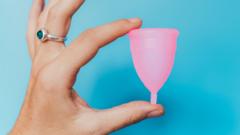A recent report highlights the significance of correct positioning and sizing of menstrual cups, as misuse can lead to serious health issues. Experts advise women to be informed to minimize risks associated with this popular menstrual product.
The Importance of Proper Use and Fit for Menstrual Cups

The Importance of Proper Use and Fit for Menstrual Cups
Doctors raise concerns about the risks associated with misaligned menstrual cups following a case of kidney problems.
Doctors are sounding the alarm over the use of menstrual cups after a case surfaced where a misaligned cup led to temporary kidney complications for a woman in her 30s. Despite being a reusable and eco-friendly option for menstruation, improper positioning of the cup can result in pressure on surrounding bodily structures, particularly the ureters, the tubes that transport urine to the bladder. This issue, though rare, underscores the need for attention to product fit and placement.
The patient had experienced chronic pelvic pain and blood in her urine for an extended period without associating these symptoms with her menstrual cup usage. Danish medical professionals, speaking through the British Medical Journal, emphasize that "correct positioning, along with choosing the correct cup shape and size, is essential to prevent adverse effects on the upper urinary tract."
Menstrual cups, constructed from soft silicone or rubber, can generally accommodate 20 to 30ml of menstrual fluid, equating to about two tablespoons. They can be worn for up to eight hours before needing to be emptied and cleaned. However, it is critical for users to choose the right size, especially for younger users or individuals who have not given birth. Initial attempts to use the cups can be challenging, with many first-time users reporting difficulties during removal, some even requiring assistance.
Health experts, including physiotherapist Dr. Kate Lough, advise that users should not simply tug on the cup’s stem during removal but instead pinch the base to break the suction seal first. Dr. Lough assures that when positioned correctly, menstrual cups should not cause discomfort. She highlights the variability in size, shape, and firmness among different types of cups, recommending users to explore various options to find their perfect fit.
Additionally, Dr. Lough cautions users about the rare but possible dislodgement of a contraceptive coil when using a menstrual cup. Should this occur, it is advisable to consult a healthcare professional while utilizing additional contraception.
Menstrual discs, which resemble cups but are positioned higher in the vaginal canal just beneath the cervix, present another option but come with their own set of considerations. As menstrual cup usage continues to gain popularity, it remains vital for users to be educated on the proper usage to avoid complications.


















